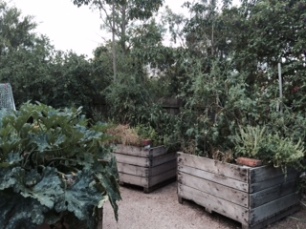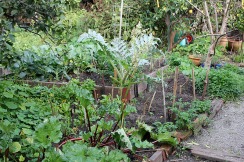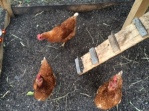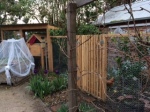First post / Previous post / Next post
There were several motivations for wanting a great backyard garden. Apart from the enjoyment and health benefits of lots of fresh greens, there is the issue of food miles. The less distance food has to travel to your plate, the less energy used by transport and storage, and therefore less carbon emissions. In addition, we wanted our garden to look good – to be an attractive and functional space for recreation and entertaining.
And be low maintenance! My partner and I both work and although I love gardening, I don’t want to spend all weekend doing it.
So, how could we make the garden more productive, protect it from the hungry local wildlife, look good and use water more efficiently? I researched for hours on the internet and then read a book I’d been given on Permaculture. My partner and I enrolled in a half-day workshop on Permaculture basics at Bulleen Art and Garden Nursery http://www.baag.com.au/ with an enthusiastic teacher named Angelo Eliades http://deepgreenpermaculture.com/, and this was enough to convince us to give it a go.
First we identified what we needed – efficient and automatic watering systems that would not require a lot of time and effort to manage, raised beds to make gardening easier on my back and a way of keeping the pests at bay. I came up with an initial design for the backyard that worked around the existing fruit trees and looked for a landscaper to help build it, as we wanted the watering systems to work properly and there was more hard labour involved than I was capable of on my own.
 The landscaper we hired was excellent. We found him through BAAG nursery in Bulleen http://www.baag.com.au/onsite-garden-services/garden-consultants/simon-marshall/ and he has lots of photos of our garden construction on his own blog http://simoncmarshall.blogspot.com.au/ . Simon liked my design but suggested lots of practical things to make it work better, like building the raised beds as wicking beds which have a reservoir of water underneath that wicks up through the soil from below. This reduces evaporation, water consumption and the time spent watering, and also ensures constant water availability for plants. The beds are lined with pond liner, and filled with 30-40cms of gravel. Then there is a layer of water-permeable landscaping fabric which allows the water to wick up into the soil layer but does not allow the soil to be washed through. About 40 cms of compost and soil goes on top. A piece of 100mm pvc pipe is inserted in one corner from the top of the bed down into the gravel so you can top up the water when needed. Last summer I did this roughly once a week if it didn’t rain, and not at all through the winter as there was enough rain to keep the reservoirs full.
The landscaper we hired was excellent. We found him through BAAG nursery in Bulleen http://www.baag.com.au/onsite-garden-services/garden-consultants/simon-marshall/ and he has lots of photos of our garden construction on his own blog http://simoncmarshall.blogspot.com.au/ . Simon liked my design but suggested lots of practical things to make it work better, like building the raised beds as wicking beds which have a reservoir of water underneath that wicks up through the soil from below. This reduces evaporation, water consumption and the time spent watering, and also ensures constant water availability for plants. The beds are lined with pond liner, and filled with 30-40cms of gravel. Then there is a layer of water-permeable landscaping fabric which allows the water to wick up into the soil layer but does not allow the soil to be washed through. About 40 cms of compost and soil goes on top. A piece of 100mm pvc pipe is inserted in one corner from the top of the bed down into the gravel so you can top up the water when needed. Last summer I did this roughly once a week if it didn’t rain, and not at all through the winter as there was enough rain to keep the reservoirs full.

 A smaller pipe on the outside of the beds allows drainage of excess water if the soil is getting too wet. Three of the wicking beds were custom built and two more were made in old orchard apple crates 120cm square – a perfect size for reaching into the middle of for planting and harvesting. They were so good we had two more installed a few months later.
A smaller pipe on the outside of the beds allows drainage of excess water if the soil is getting too wet. Three of the wicking beds were custom built and two more were made in old orchard apple crates 120cm square – a perfect size for reaching into the middle of for planting and harvesting. They were so good we had two more installed a few months later.
Another addition was a grey water system from the washing machine which snakes around the fruit trees under a layer of mulch. The rest of the garden is watered by drip irrigation on an electronic timer, that can be switched between tank water and mains if the tanks run low. Timber for the wicking beds was sourced from old golden cypress trees, which had been removed and replaced after being used for farm windbreaks for 100 years. The paving under the table is recycled concrete.

![FullSizeRender[4]](https://towardsazeroemissionshouse.files.wordpress.com/2015/09/fullsizerender4.jpg?w=223&h=170)
We planted more fruit trees, so in addition to the two old apple trees and pomegranate, we now have two pears, two plums, a fig, and quince, two oranges, a mandarin, a lemon, two limes and (our most recent experiment) a hass avocado. I’ve also put three olive trees in large pots on the back deck.
 We have a raspberry and strawberry patch, a loganberry climbing on one side of the verandah and grapes on the other, and kiwi fruit climbing up the old almond tree. We have a constant supply of fresh greens, herbs and seasonal veggies. A bird net draped over bamboo stakes in each corner of the wicking boxes keeps the birds and possums off the more popular crops. The net holes are big enough for the bees to get through for pollination.
We have a raspberry and strawberry patch, a loganberry climbing on one side of the verandah and grapes on the other, and kiwi fruit climbing up the old almond tree. We have a constant supply of fresh greens, herbs and seasonal veggies. A bird net draped over bamboo stakes in each corner of the wicking boxes keeps the birds and possums off the more popular crops. The net holes are big enough for the bees to get through for pollination.
This year we also added a chook pen and three chooks and asked our landscaper back to build a low-maintenance pen and run so we can enjoy the eggs without too much hard work.






Great blog. We look forward to seeing how your household narrative unfolds.
David Holmgren is completing his “Retrofitting the suburbs’ book at the moment and as yours is an example of the household economy in transition you may be interested in the other case studies that are told through that book that concentrate on household and community transition. The more we have worked in with our neighbours, friends and in-walking-and-bike-riding-distance community the easier our transition has become. Lessening our reliance on the monetary economy has lessened our waste, emissions and stress. While its clear the monetary economy has to go into degrowth, the household and community (non-monetary) economies need to go into growth — abundant growth.
Thank you for sharing your transition.
LikeLike
Thanks. I’ll look out for David’s book when it’s published.
LikeLike